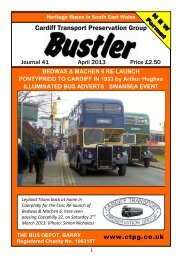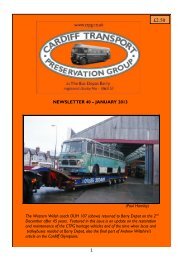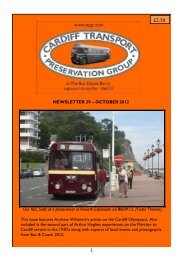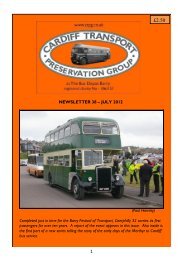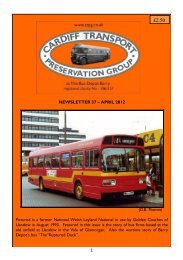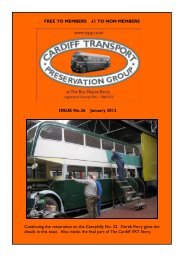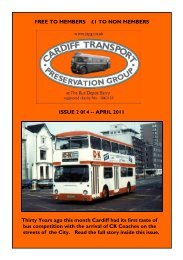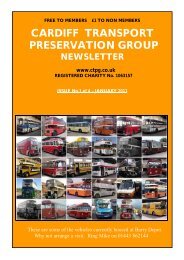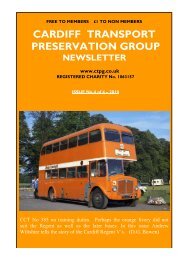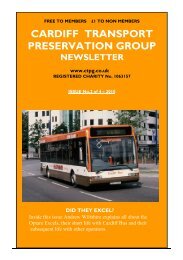Create successful ePaper yourself
Turn your PDF publications into a flip-book with our unique Google optimized e-Paper software.
COMMENTS ON RECENT NEWSLETTERS;<br />
Dear Editor,<br />
Comments on items published in recent newsletters may be <strong>of</strong> interest to the group.<br />
Re. CARDIFF’s REGENT V’s;<br />
Firstly, many thanks to Andrew Wiltshire for his excellent series on the vehicles bought<br />
by City <strong>of</strong> Cardiff Transport. In the December article on the AEC Regent V he mentions<br />
exposed-radiator examples which operated in England, but doesn’t mention those which<br />
operated nearer to home. Bedwas & Machen U.D.C. had a single example, no. 9 (PWO<br />
783) with a Longwell Green lowbridge body and the Rhondda Transport Co. had no less<br />
than 27 examples with Weymann highbridge bodies <strong>–</strong> 298/9, 400-424 (STG 869-876,<br />
TTX 984-998, UNY 4-7); all <strong>of</strong> these vehicles were new in 1956. I always thought these<br />
vehicles looked rather odd, as the front dash was obviously constructed for a concealed<br />
radiator!<br />
Re. DWO 123;<br />
Between 1903 and 1921, local authorities used differing systems to allocate vehicle<br />
registration numbers. Some authorities used even numbers for cars and odd numbers for<br />
commercial vehicles and buses, motor cycles were sometimes issued numbers 1-999 or<br />
1-1999 in each series. Other local authorities kept three registers <strong>–</strong> one for motor<br />
cycles, a second for cars and light commercials and a third for ‘heavy motor cars’<br />
(commercials and road locomotives); these authorities either allocated blocks <strong>of</strong><br />
numbers for each type <strong>of</strong> vehicle or, more unusually, issued the same series <strong>of</strong> numbers<br />
for each type <strong>of</strong> vehicle, leading to duplication. This was further compounded by most<br />
authorities re-issuing the registration number <strong>of</strong> a vehicle <strong>of</strong>ficially notified as being<br />
scrapped. Following changes in legislation in 1921, the re-issue <strong>of</strong> voided registrations<br />
ceased and vehicles carrying duplicated registrations were re-registered to remove the<br />
anomaly.<br />
What has all this got to do with DWO 123 you may ask? Well, some authorities issued<br />
registrations <strong>of</strong> the format xx-0nnn to heavy motor cars; examples being Norfolk issuing<br />
AH-0nnn and Buckinghamshire BH-0nnn, this led to Hampshire omitting AHO and BHO<br />
from its sequence <strong>of</strong> issues. I have seen one photograph (I can’t remember where,<br />
unfortunately) <strong>of</strong> a traction engine or road locomotive carrying a registration in<br />
Newport’s DW-0nnn series and this may be the reason DWO was not allocated to<br />
neighbouring Monmouthshire. All two and three letter registration marks had to be<br />
individually authorised by a ‘Statutory Instrument.’ DWO was eventually authorised for<br />
issue in the 1990s when most previously un-issued (and non-abusive) combinations were<br />
authorised, either so that an appropriate registration could be allocated to an historic<br />
vehicle or, more usually, could be included in the DVLA’s ‘Sale <strong>of</strong> Marks’ scheme!<br />
Regards, Mike Street (member 0306)<br />
(Thanks Mike for your comments and giving us the most likely explanation <strong>of</strong> the nonappearance<br />
<strong>of</strong> the DWO mark.)<br />
4




